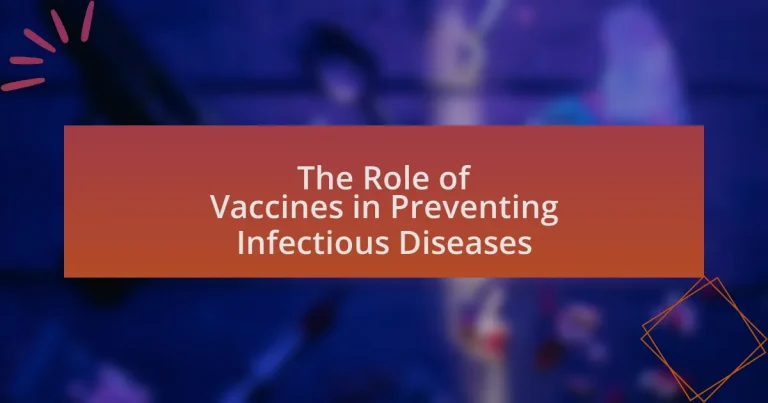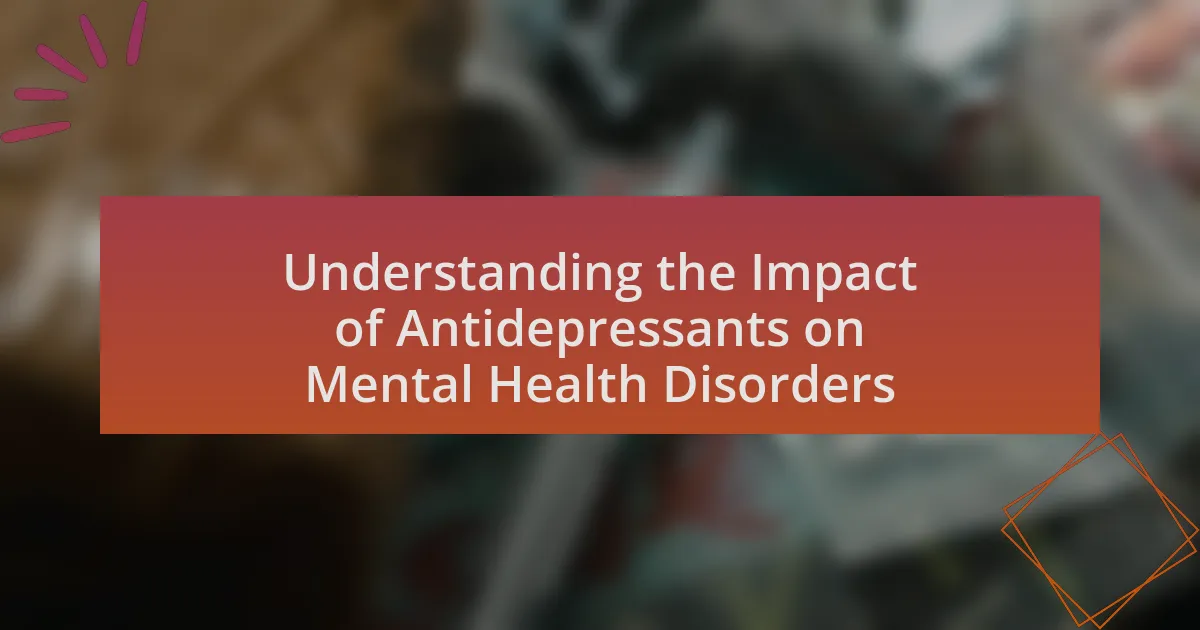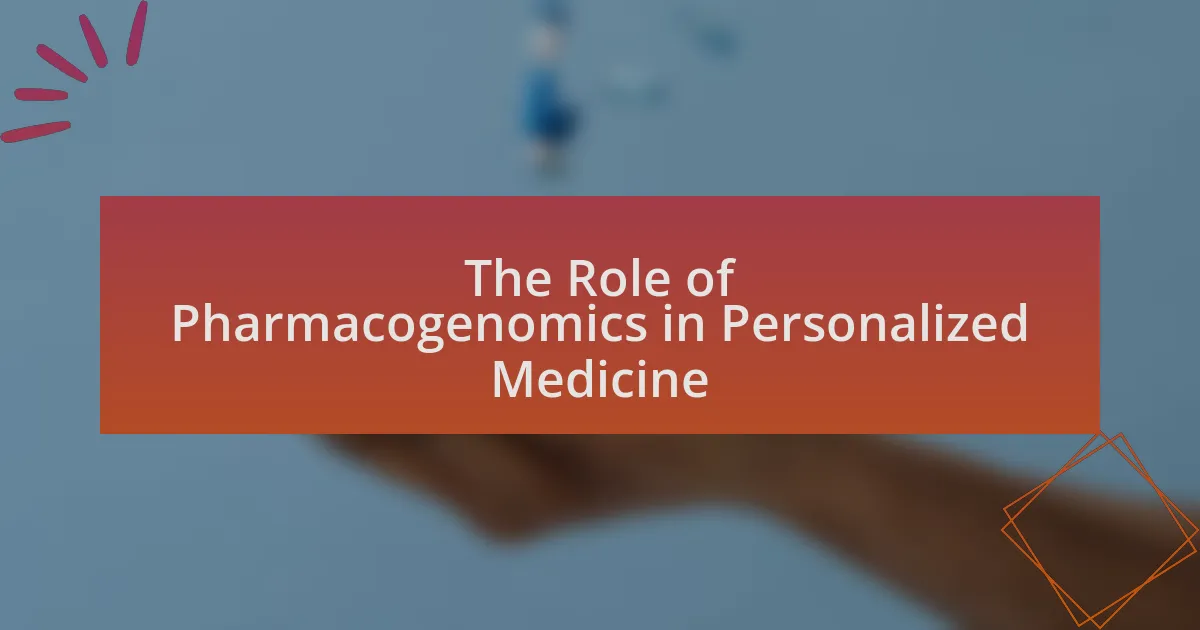Vaccines are essential tools in preventing infectious diseases by stimulating the immune system to recognize and combat pathogens. This article explores the mechanisms by which vaccines work, the various types available, and their significant impact on public health, including the concept of herd immunity. It also addresses challenges in vaccine implementation, factors influencing vaccine acceptance, and the role of healthcare providers in education. Furthermore, the article discusses global health initiatives aimed at improving vaccine distribution and the future directions of vaccine technology, emphasizing the importance of effective communication strategies to enhance vaccine uptake in communities.
What is the role of vaccines in preventing infectious diseases?
Vaccines play a crucial role in preventing infectious diseases by stimulating the immune system to recognize and combat pathogens. When administered, vaccines introduce antigens that mimic disease-causing organisms, prompting the body to produce an immune response without causing the disease itself. This process leads to the development of immunological memory, enabling the immune system to respond more effectively upon future exposure to the actual pathogen.
For instance, the widespread use of the measles vaccine has led to a dramatic decline in measles cases globally, with the World Health Organization reporting a 73% decrease in measles deaths between 2000 and 2018 due to vaccination efforts. This demonstrates that vaccines not only protect individuals but also contribute to herd immunity, reducing the overall prevalence of infectious diseases in the population.
How do vaccines work to protect against diseases?
Vaccines work by stimulating the immune system to recognize and fight specific pathogens, such as viruses or bacteria, thereby providing protection against diseases. When a vaccine is administered, it introduces a harmless component of the pathogen, such as an inactivated virus, a weakened form of the virus, or a piece of its genetic material. This exposure prompts the immune system to produce antibodies and activate T-cells, which are essential for identifying and eliminating the pathogen if the body encounters it in the future.
For instance, the measles vaccine contains a weakened form of the measles virus, which triggers the immune response without causing the disease. Studies have shown that vaccination has led to a significant decline in measles cases, with the World Health Organization reporting a 73% decrease in global measles deaths between 2000 and 2018 due to widespread vaccination efforts. This demonstrates the effectiveness of vaccines in preventing infectious diseases by preparing the immune system for future encounters with the actual pathogens.
What are the different types of vaccines available?
The different types of vaccines available include inactivated or killed vaccines, live attenuated vaccines, subunit, recombinant, and conjugate vaccines, and mRNA vaccines. Inactivated vaccines contain pathogens that have been killed or inactivated, such as the polio vaccine. Live attenuated vaccines use a weakened form of the virus, like the measles, mumps, and rubella (MMR) vaccine. Subunit, recombinant, and conjugate vaccines include only parts of the pathogen, such as the hepatitis B vaccine, which uses a protein from the virus. mRNA vaccines, like the Pfizer-BioNTech and Moderna COVID-19 vaccines, use messenger RNA to instruct cells to produce a protein that triggers an immune response. Each type of vaccine works by stimulating the immune system to recognize and fight off specific pathogens, thereby preventing infectious diseases.
How do vaccines stimulate the immune response?
Vaccines stimulate the immune response by introducing antigens, which are components of pathogens, into the body. This exposure prompts the immune system to recognize these antigens as foreign, leading to the activation of immune cells such as T cells and B cells. T cells help in directly attacking infected cells, while B cells produce antibodies that neutralize pathogens. The process also includes the formation of memory cells, which remain in the body and enable a faster and more effective response upon future exposure to the same pathogen. This mechanism is supported by extensive research, including studies published in journals like “Nature Reviews Immunology,” which detail how vaccines prepare the immune system for real infections by mimicking the presence of pathogens without causing disease.
Why are vaccines important for public health?
Vaccines are crucial for public health because they prevent the spread of infectious diseases, thereby protecting individuals and communities. By stimulating the immune system to recognize and fight specific pathogens, vaccines significantly reduce the incidence of diseases such as measles, polio, and influenza. For instance, the World Health Organization reports that vaccination has led to a 73% drop in measles deaths globally between 2000 and 2018. This demonstrates that widespread vaccination not only protects vaccinated individuals but also contributes to herd immunity, which is essential for safeguarding those who cannot be vaccinated due to medical reasons.
What impact do vaccines have on disease outbreaks?
Vaccines significantly reduce the incidence and spread of infectious diseases during outbreaks. By stimulating the immune system to recognize and combat pathogens, vaccines create herd immunity, which protects both vaccinated individuals and those who cannot be vaccinated. Historical data shows that the introduction of vaccines has led to dramatic declines in diseases such as smallpox and polio; for instance, smallpox was eradicated globally by 1980 due to widespread vaccination efforts. Additionally, the Centers for Disease Control and Prevention (CDC) reports that vaccines prevent an estimated 2-3 million deaths each year from diseases like measles and diphtheria.
How do vaccines contribute to herd immunity?
Vaccines contribute to herd immunity by increasing the proportion of immune individuals in a population, which reduces the overall spread of infectious diseases. When a significant percentage of the population is vaccinated, the likelihood of disease transmission decreases, protecting those who are unvaccinated or cannot be vaccinated, such as infants or individuals with certain medical conditions. For example, studies show that when vaccination rates exceed 90-95% for diseases like measles, herd immunity can effectively prevent outbreaks, as the virus has fewer opportunities to spread. This collective immunity is crucial for controlling infectious diseases and safeguarding public health.
What are the challenges associated with vaccine implementation?
The challenges associated with vaccine implementation include logistical issues, public hesitancy, and equitable access. Logistical issues encompass the distribution and storage of vaccines, particularly those requiring cold chain management, which can complicate delivery in remote areas. Public hesitancy often arises from misinformation or distrust in healthcare systems, leading to lower vaccination rates. Equitable access is a significant challenge, as socioeconomic disparities can result in unequal availability of vaccines, particularly in low-income regions. These factors collectively hinder the effectiveness of vaccination programs aimed at preventing infectious diseases.
What factors influence vaccine acceptance among populations?
Vaccine acceptance among populations is influenced by factors such as trust in healthcare systems, perceived vaccine safety and efficacy, cultural beliefs, and access to information. Trust in healthcare providers significantly impacts individuals’ willingness to receive vaccines; studies show that communities with higher trust levels report greater vaccine uptake. Perceptions of vaccine safety and efficacy are critical, as misinformation can lead to hesitancy; for instance, a survey by the World Health Organization indicated that concerns about side effects are a primary reason for vaccine refusal. Cultural beliefs and social norms also play a role, as individuals may be influenced by family, friends, or community leaders regarding vaccination decisions. Additionally, access to accurate information and healthcare services can either facilitate or hinder vaccine acceptance, with populations lacking resources often showing lower vaccination rates.
How does misinformation affect vaccination rates?
Misinformation significantly decreases vaccination rates by fostering fear and skepticism among the public. Studies have shown that exposure to false information about vaccine safety and efficacy can lead to increased vaccine hesitancy. For instance, a 2019 study published in the journal “Vaccine” found that misinformation on social media was linked to a 6% decrease in vaccination rates in communities where such misinformation was prevalent. This decline in trust can result in lower immunization coverage, ultimately jeopardizing herd immunity and increasing the risk of outbreaks of vaccine-preventable diseases.
What role do healthcare providers play in vaccine education?
Healthcare providers play a crucial role in vaccine education by delivering accurate information about vaccines, addressing misconceptions, and promoting vaccination as a key public health measure. They serve as trusted sources of information, helping patients understand the benefits and risks associated with vaccines, which is essential for informed decision-making. Studies show that when healthcare providers actively engage in discussions about vaccines, vaccination rates increase significantly; for instance, a study published in the journal “Vaccine” found that provider recommendations are one of the strongest predictors of vaccination uptake.
How do global health initiatives address vaccine distribution?
Global health initiatives address vaccine distribution by implementing coordinated strategies that ensure equitable access to vaccines across different populations. These initiatives, such as Gavi, the Vaccine Alliance, and the World Health Organization’s COVAX program, focus on logistics, funding, and partnerships to facilitate the delivery of vaccines to low- and middle-income countries. For instance, Gavi has supported the distribution of over 1.5 billion vaccine doses since its inception in 2000, significantly increasing immunization rates in underserved regions. Additionally, COVAX aims to deliver 2 billion doses of COVID-19 vaccines globally by the end of 2021, emphasizing the importance of equitable access during health emergencies.
What are the barriers to vaccine access in low-income countries?
Barriers to vaccine access in low-income countries include inadequate healthcare infrastructure, high costs of vaccines, and limited supply chains. In many low-income regions, healthcare facilities are often under-resourced, lacking essential equipment and trained personnel to administer vaccines effectively. Additionally, the financial burden of purchasing vaccines can be prohibitive, as many countries struggle with budget constraints and rely on external funding. Furthermore, logistical challenges such as poor transportation networks hinder the distribution of vaccines, leading to delays and shortages. According to the World Health Organization, these factors contribute to lower vaccination rates, which can exacerbate the spread of infectious diseases in these populations.
How do international organizations support vaccination efforts?
International organizations support vaccination efforts by providing funding, technical assistance, and coordination among countries. For instance, the World Health Organization (WHO) plays a crucial role in setting vaccination guidelines, monitoring disease outbreaks, and facilitating vaccine distribution through initiatives like COVAX, which aims to ensure equitable access to COVID-19 vaccines globally. Additionally, organizations such as UNICEF and Gavi, the Vaccine Alliance, work to strengthen immunization programs in low-income countries by supplying vaccines, training healthcare workers, and raising public awareness about the importance of vaccination. These efforts are vital in reducing vaccine-preventable diseases and improving global health outcomes.
What are the future directions for vaccines in infectious disease prevention?
Future directions for vaccines in infectious disease prevention include the development of mRNA technology, which has shown promise in rapid vaccine production and adaptability to emerging pathogens. This approach was successfully demonstrated during the COVID-19 pandemic, where mRNA vaccines were developed and distributed in record time, highlighting their potential for addressing future infectious threats. Additionally, researchers are focusing on universal vaccines, such as those targeting influenza and coronaviruses, which aim to provide broader and longer-lasting immunity. Advances in adjuvant technology and delivery systems, including nanoparticle-based vaccines, are also being explored to enhance immune responses. These innovations are supported by ongoing research and clinical trials, indicating a significant shift towards more effective and versatile vaccination strategies in the fight against infectious diseases.
How is vaccine technology evolving?
Vaccine technology is evolving through advancements in mRNA technology, viral vector platforms, and protein subunit vaccines. These innovations enhance the speed and efficiency of vaccine development, as demonstrated by the rapid creation of COVID-19 vaccines using mRNA technology, which allowed for a quicker immune response and adaptability to variants. Additionally, ongoing research into nanoparticle-based vaccines and adjuvants aims to improve efficacy and broaden immune responses, as seen in studies highlighting their potential in targeting various pathogens.
What are mRNA vaccines and how do they differ from traditional vaccines?
mRNA vaccines are a type of vaccine that use messenger RNA to instruct cells to produce a protein that triggers an immune response. Unlike traditional vaccines, which often use weakened or inactivated forms of a virus or bacteria to stimulate immunity, mRNA vaccines do not contain live pathogens. Instead, they deliver genetic instructions that enable the body to recognize and fight off the actual virus if encountered in the future. This innovative approach allows for a quicker development process and can be adapted rapidly to emerging infectious diseases, as demonstrated by the rapid deployment of mRNA vaccines during the COVID-19 pandemic.
What potential do new vaccine platforms hold for future diseases?
New vaccine platforms hold significant potential for addressing future diseases by enabling rapid development and deployment of vaccines tailored to emerging pathogens. These platforms, such as mRNA and viral vector technologies, allow for quicker adaptation to genetic changes in viruses, as evidenced by the swift creation of COVID-19 vaccines using mRNA technology, which was developed in less than a year. This adaptability enhances the ability to respond to pandemics and outbreaks, thereby improving public health outcomes. Additionally, new platforms can facilitate the design of vaccines that target multiple strains or variants of a pathogen, further increasing their effectiveness in preventing infectious diseases.
What best practices can enhance vaccine uptake in communities?
Best practices that can enhance vaccine uptake in communities include implementing community engagement strategies, providing accessible vaccination services, and utilizing effective communication campaigns. Community engagement fosters trust and addresses specific concerns, which is crucial for increasing participation. Accessible vaccination services, such as mobile clinics and extended hours, remove barriers to access, making it easier for individuals to receive vaccines. Effective communication campaigns that use clear, factual information about vaccine safety and efficacy can counter misinformation and encourage positive attitudes towards vaccination. Research indicates that communities with strong engagement and accessible services see higher vaccination rates, as evidenced by studies showing that targeted outreach can increase uptake by up to 30%.
How can public health campaigns effectively promote vaccination?
Public health campaigns can effectively promote vaccination by utilizing targeted messaging, community engagement, and leveraging trusted local leaders. Targeted messaging addresses specific concerns and misconceptions about vaccines, which can increase acceptance; for instance, campaigns that highlight the safety and efficacy of vaccines have been shown to improve vaccination rates. Community engagement fosters trust and encourages participation through local events and outreach programs, which can lead to higher vaccination uptake. Additionally, involving trusted local leaders, such as healthcare professionals and community figures, can enhance credibility and influence public perception positively, as evidenced by studies indicating that endorsements from these figures significantly increase vaccination willingness.
What strategies can be employed to address vaccine hesitancy?
To address vaccine hesitancy, effective strategies include enhancing communication, building trust, and providing accessible information. Enhancing communication involves using clear, empathetic messaging that addresses specific concerns and misconceptions about vaccines. Building trust can be achieved by engaging community leaders and healthcare professionals who can advocate for vaccination based on their credibility. Providing accessible information entails ensuring that educational resources are available in multiple languages and formats, making it easier for diverse populations to understand the benefits and safety of vaccines. Research indicates that targeted interventions, such as community outreach programs, can significantly increase vaccination rates by directly addressing the fears and doubts of hesitant individuals.





